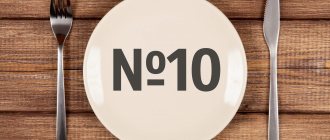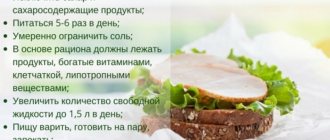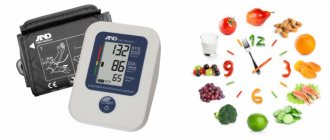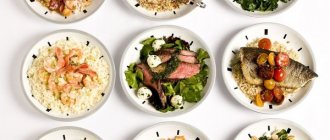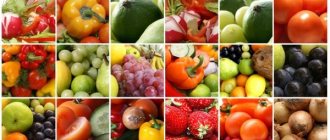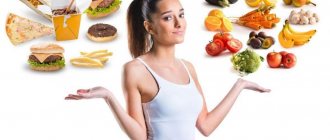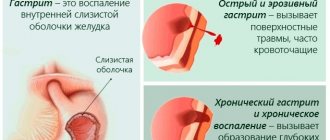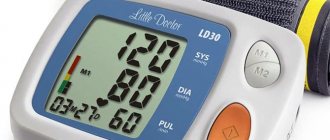Nutritional features for hypercholesterolemia
- Fractional meals. The basic principle is to eat even when you don’t feel like it, but in small portions (100-200 g), 5-6 times a day.
- Ease of preparation. If you have high cholesterol, fried, smoked, pickled foods, and any preserves are strictly prohibited.
- Breakfast. Should consist of carbohydrates - porridge cooked in water or low-fat milk.
- Dinner. Must include soup or broth and hot dishes, for example, boiled fish or meat with a side dish.
- Dinner. Preference should be given to salads, vegetables with fish or meat.
- Lunch and afternoon tea. Fruit salads, fruits, fresh vegetables, dried fruits, nuts, and dairy products are ideal as snacks.
- 1 hour before bedtime, it is recommended to drink a glass of kefir, natural yogurt or freshly prepared vegetable juice.
- You need to drink about 1-1.5 liters of water per day. You cannot replace it with tea, compotes, or herbal decoctions.
- It is very important to reduce your consumption of animal fats by at least a third.
- It is advisable to completely give up coffee. Or drink no more than 1 cup a day of a brewed natural drink. Ginger tea has a good tonic effect. This is a good alternative to invigorating, but harmful coffee for high cholesterol.
When preparing a diet, women are advised to include more soy products containing phytoestrogens in the menu, consume sprouted wheat grains more often, and drink more natural juices. It is advisable to reduce sugar consumption and move more.
Men should carefully monitor their protein intake, eat more legumes and fish, give up salt or limit its amount to 8 g per day. Along with proper nutrition, it is advisable to completely give up bad habits (smoking, alcoholic drinks).
Very often, hypercholesterolemia is combined with pathologies of internal organs: high blood sugar, disturbances in the functioning of the thyroid gland, liver, and kidneys. This situation requires a special approach.
Basic principles of the diet
The main rule of the diet is limited consumption of foods with saturated fats. The daily requirement for cholesterol in humans is 1000 mg. At the same time, the body is able to produce it itself in an amount of 80%. The remaining 20% comes from animal products.
Indulging in fast food and excessively fatty foods has a negative impact on your health. If there is an increase in blood sugar, then the diet must be taken very seriously.
People who do not have health problems can also follow the principles of a low-cholesterol diet as a preventive measure.
To effectively get rid of this organic compound, you must follow the following principles:
- Fractional meals. Food must be taken in small portions and more often. Thanks to this, the risk of eating excess food is minimal.
- Limited consumption of animal fats - they have a greater effect on blood cholesterol levels. Use olive oil for fried foods.
- Limited salt intake. The daily dose should not exceed 5 grams. Salt retains interstitial fluid and promotes the formation of edema.
- Complete cessation of alcohol and smoking. These bad habits provoke blood thickening, which leads to a number of complications.
- The amount of meat at one time should not exceed 100 grams.
- Moderate consumption of milk and milk-containing products.
- The bird must be eaten without fat and skin.
- During stewing, the lack of oil can be compensated for with plain water.
- An important feature of the diet is the consumption of fiber, because it prevents the absorption of cholesterol into the gastrointestinal tract. The largest amount of it contains cereals, vegetables, and fruits. Choose vegetables that contain a minimum of starch. Onions and garlic are also very healthy and should be consumed raw.
- Consuming vitamin D, a lot of which is found in fish.
The diet will help improve your general condition, reduce the amount of fat and improve metabolic processes in the body.
Table of recommended and prohibited foods for high cholesterol
| Recommended | Limited | Forbidden |
| Fish and seafood | ||
|
Can be consumed no more than 2 times a week, boiled, in small portions of about 100 g. |
|
| Meat products | ||
They are introduced into the menu in portions of no more than 100 g, every other day. |
| |
| Oils, fats | ||
|
Add to prepared dishes. Norm 2 tbsp. l. in a day. |
|
| Dairy and fermented milk products | ||
Fat content from 0.5 to 5%. |
No more than 3 times a week. |
|
| Vegetables | ||
| Fresh and frozen vegetables, corn, beans, lentils. | Boiled potatoes no more than 3 times a week. |
|
| Fruits | ||
| Any fresh fruit. | It is recommended to consume dried fruits every other day. |
|
| Cereals | ||
|
|
|
| Bakery | ||
|
You can eat a slice of white bread or 2-3 cookies for breakfast, but not more than 3 times a week. |
|
| Sweets | ||
| Soy chocolate - no more than 4-6 times a month. |
|
| Beverages | ||
|
It is advisable to include these drinks in the menu no more than 3-4 times a week. |
|
Products that are recommended to be excluded
If it is not possible to get advice from a nutritionist or nutritionist, you can independently study the list of prohibited foods. It is recommended to avoid:
- refined products: oils, white flour and sugar;
- fats: margarine, lard, goose fat;
- industrial sweets, buns;
- fatty dairy and fermented milk products: cheeses, cottage cheese, condensed milk, sour cream, cream, ice cream;
- coffee, black tea, alcohol, sweet carbonated water;
- rich soups with meat broth, packaged soups;
- fatty sauces, mayonnaise;
- meat with visible layers of fat, offal, duck and goose;
- shrimp, squid, fatty, fried fish (flounder, herring, sardines, cod);
- chips, French fries, pistachios, peanuts;
- butter creams, chocolate.
It is necessary to strictly limit sugar, fish roe, butter, and cream. It is better to replace cow's curd with goat's curd.
Menu for the week
A diet for high cholesterol in men involves creating a menu for the week. This will allow you to avoid accidental snacking on non-recommended products, and will save time and money in the process of purchasing and preparing food.
| Monday | Breakfast: - oatmeal with berries, apples, seasonal fruits + flaxseed; — freshly squeezed orange/apple juice. Lunch: - pickle soup in vegetable broth with rice and herbs; - steamed chicken fillet cutlets; - currant or cranberry juice. Afternoon snack: - 30 grams of walnuts + cashew nuts; - blackcurrant decoction with light honey. Dinner: — Steamed fish with seasonal vegetables; - whole grain bread. |
| Tuesday | Breakfast: - Greek yogurt with apples, plums, raspberries, pears; — green tea with buckwheat honey; - oatmeal with dried fruits. Lunch: - vegetable hodgepodge based on potatoes, tomatoes, olives; — country-style potatoes baked with aromatic herbs, basil, pepper, coarse sea salt; - grilled fish. Afternoon snack: - stewed apples with raisins, walnuts, honey; Dinner: - potato gnocchi with beans stewed in tomatoes and spinach. - green tea. |
| Wednesday | Breakfast: - whole grain bread with honey, berry jam; - berry smoothie based on almond milk. Lunch: - cream soup of lentils, leeks, potatoes with the addition of herbs and smoked paprika; - pancakes made from chickpea flour with minced meat based on boiled lentils and vegetables (bell peppers, tomatoes, broccoli). To prepare minced meat, simmer all components until tender, then blend with a blender; — bean brownie, poppy seed milk with strawberries. Afternoon snack: - Fruits with walnuts and herbal tea. Dinner: - pearl barley porridge stewed with vegetables; - low-fat fish fillet, baked in the oven with cumin, black pepper, olive oil. |
| Thursday | Breakfast: - buckwheat porridge with vegetable milk; - smoothie (banana + blueberries + currants + spinach + 2 dates + 2 tablespoons of flaxseed) Lunch: - whole grain noodles with beans stewed in tomato sauce; — cream soup of cauliflower, potatoes, carrots with the addition of herbs and dark bread croutons; - rosehip decoction. Afternoon snack: - 2 any seasonal fruits; - berry juice. Dinner: - low-fat cottage cheese casserole; - berry drink. |
| Friday | Breakfast: - herbal tea with lemon and orange zest; - sweet rice porridge with zucchini, raisins, cinnamon. Lunch: - boiled chicken fillet with sliced vegetables, seasoned with olive oil and lemon juice with balsamic vinegar; - vegetable soup with potatoes, green peas, cauliflower or white cabbage, bell peppers, tomatoes. Afternoon snack: - fresh fruit with rosehip infusion. Dinner: - bulgur with vegetables and tomatoes; - homemade bread made from whole grain flour, green buckwheat, sunflower seeds; — smoothie with banana, berries, spinach. |
| Saturday | Breakfast: - corn porridge with zucchini; - green tea. Lunch: - brown rice, stewed with vegetables and lean chicken fillet; - red borscht in vegetable broth; - decoction with dried fruits and light honey. Afternoon snack: - apple and carrots, grated on a coarse grater with the addition of raisins and dried apricots. Dinner: - millet porridge with vegetable milk; - rosehip decoction |
| Sunday | Breakfast: - pancakes with coconut flakes made from whole grain flour with flax seeds and jam; - carob with almond milk; - banana. Lunch: - pearl barley soup in vegetable broth with herbs; - whole wheat bread; - boiled chickpeas with vegetables. Afternoon snack: - Biscuits without margarine; — herbal tea with lemon balm, mint, hibiscus, raspberries, strawberries. Dinner: — risotto with mushrooms and seasonal vegetables; - stewed fish; - rosehip with light honey. |
Balanced diet
For the full functioning of systems and organs, the human body must receive proteins, fats and carbohydrates from food every day. Therefore, even with a high concentration of cholesterol in the blood, it is impossible to completely abandon animal fats.
Proteins (proteins)
They are high molecular weight organic substances. Consist of alpha acids.
The greatest amount of protein is contained:
- lean veal;
- chicken breast;
- shrimps;
- sea fish;
- legumes
When planning your diet, it is important to consider that some of these foods contain high amounts of cholesterol. For example, shrimp or veal. Therefore, they can be included in the menu no more than 2 times a week.
Fats
Fats are a source of energy for the body. If you have high cholesterol, avoid saturated fats, which can increase levels of harmful LDL.
Preference should be given to vegetable, unsaturated fats, which are found in the following products:
- vegetable oils;
- nuts;
- dairy, fermented milk products.
Sea fish deserves special attention. It contains a lot of cholesterol, but it is not dangerous because its harmful effects are neutralized by unsaturated fatty acids. Therefore, in addition to vegetables and fruits, sea fish is an essential element of nutrition. It can be added to the menu every day.
Carbohydrates
Carbohydrates are simple and complex sugars, a source of energy, building material for cells. Their deficiency immediately affects the state of the body: the functioning of the cardiovascular system is disrupted, the metabolic rate drops, and the condition of the nervous system worsens.
The largest amount of carbohydrates is contained:
- whole wheat bread;
- vegetables fruits;
- legumes;
- whole grains;
- low-fat dairy products.
It is important to know that there is a separate group of carbohydrates called refined. They do not replenish the lack of energy in the body, but rather completely deplete the energy supply. Refined carbohydrates are easily digested.
They are developed artificially, therefore they are completely devoid of useful qualities. When there is an excess of them, they begin to quickly turn into fats. The diet completely excludes foods containing refined carbohydrates. These include confectionery, baked goods, sweets, and carbonated drinks.
Consequences of high cholesterol
The predominance of carbohydrates and saturated fats in the diet increases cholesterol levels and leads to various disorders and diseases in the body.
The most dangerous of them are:
- atherosclerosis with the formation of plaques on the walls of blood vessels, narrowing the lumen of veins and arteries, and in some cases causing complete blockage;
- cardiovascular diseases (myocardial infarction, stroke, gangrene of the extremities and others);
- fatty hepatosis, cholesterosis, pancreatitis, diabetes mellitus;
- diseases of the gastrointestinal tract;
- increased blood pressure (hypertension).
You can reduce your cholesterol level by adjusting your menu and eliminating high-calorie and fatty foods as much as possible. This diet is based on table No. 10 and is called a hypocholesterol diet for patients with hypertension and people with high cholesterol in the blood.
What you can and cannot eat if you have high cholesterol
Medical nutrition includes many products that combine well with each other, which allows you to make your diet varied.
What you can eat:
- cereals: black and red rice, buckwheat, bulgur, quinoa, rolled oats, couscous;
- sea fish: tuna, hake, pollock, cod, salmon, blue whiting, hake;
- legumes: white and red beans, lentils, chickpeas;
- nuts: pine, walnuts, hazelnuts, almonds, cashews;
- vegetable oils: olive, flaxseed, soybean, unrefined sunflower;
- eggs: white;
- dairy, fermented milk products with a fat content of up to 5%: milk, yogurt (without flavorings, flavoring additives), cottage cheese;
- baked goods: whole grain bread, oatmeal cookies, crackers, biscuits;
- soybeans, products made from them;
- greens: parsley, dill, green onions;
- desserts: puddings, fruit jellies, berry smoothies;
- drinks: green and ginger tea, natural fruit or vegetable juices, decoctions with rose hips, chamomile, fruit drinks.
Vegetables and fruits should form the basis of the diet. They can be eaten fresh, frozen, boiled or stewed.
In limited quantities, no more than 2-3 times a week, it is recommended to consume:
- river fish, seafood: pike, perch, crabs, shrimp, mussels;
- dietary meats: chicken breast fillet, turkey, rabbit, lean veal;
- fermented milk products: cheese with fat content up to 20%, sour cream – up to 15%;
- mashed potatoes with milk;
- dried fruits (except raisins);
- White bread;
- egg yolk;
- durum wheat pasta;
- drinks: jelly, dried fruit compote, cocoa, natural red wine.
All of the above foods contain cholesterol. Therefore, they need to be introduced into the diet in limited quantities. Their excess increases the amount of fat and aggravates atherosclerotic changes in blood vessels.
What not to eat:
- any types of offal;
- caviar;
- fatty meats: pork, beef, lamb;
- meat, fish semi-finished products, canned food;
- oils, fats: butter, palm oil, coconut oil, lard, margarine;
- dairy products: condensed or homemade whole milk, cream, curd masses;
- fast food;
- cereals: semolina, white rice;
- baked goods, sweets;
- highly carbonated drinks, lemonades.
By following proper nutrition, you can reduce cholesterol levels within 2-3 months.
What can't you eat?
If the indicator slightly exceeds the norm, then the list of products listed below must be limited. If the dose is greatly exceeded, stop taking them completely.
Food products that are prohibited:
- Foods rich in carbohydrates and with a significant sugar content: baked goods, desserts, sweets.
- Dishes prepared from the internal organs of animals, namely: liver, tongue, kidneys, heart.
- Smoked meats and sausages are rich in unhealthy fats.
- Products containing milk. Cream and sour cream are very fatty in composition; they should be consumed as little as possible. Mayonnaise is prohibited; if possible, it should be completely excluded from the diet. Salads can be seasoned with oil from corn, olives, sunflowers, and flax.
- You should not eat the yolk of a chicken egg, as it contains excessive amounts of cholesterol. If we consider the egg as a whole, it contains a sufficient amount of chloramphenicol, which reduces the harmful substances contained in the yolk.
- Instead of fatty meats, you should pay attention to poultry and fish.
- Shrimps.
- Ice cream, because it contains a lot of sugar.
- Fast food: hot dogs, hamburgers, and chips.
- Fat must be removed from meat before cooking. The ideal option is beef, lamb, horse meat.
- Different types of cheeses.
Cholesterol-lowering foods
Due to their properties, they help to effectively reduce the concentration of harmful lipoproteins and increase the amount of useful ones. The most effective in this regard are:
- Cold pressed olive oil. Most useful for high cholesterol. Source of plant sterols. Reduces total cholesterol by 13-15%.
- Avocado. Contains the highest amount of phytosterols of any fruit. These substances reduce the ability of the small intestine to absorb fatty particles and remove them from the body. If you eat half an avocado for breakfast every day, after 3-4 weeks the concentration of total cholesterol will decrease by 8-10%, but only if you follow the rules of a healthy diet.
- Kiwi, apples, black currants, watermelons. True natural antioxidants. Normalize lipid metabolism, eliminate free radicals. Reduces cholesterol by 5-7% when consumed for 2-3 months.
- Soybeans and legumes are rich in plant fiber. It effectively cleanses blood vessels, quickly binds low-density lipoproteins, and removes them from the body before they enter the general bloodstream.
- Lingonberries, cranberries, pomegranates, strawberries, red currants, raspberries, and red grapes lower cholesterol levels by 15-18%. Berries are rich in polyphenols. They cleanse blood vessels and remove harmful substances from the body. Prevents the development of cancer and diabetes.
- Tuna, mackerel, cod, trout, salmon. Fish contains fatty acids (omega-3, omega-6). They regulate lipid metabolism, cleanse blood vessels from atherosclerotic plaques, and strengthen cell membranes. It is recommended to include fish in the diet every day, in small quantities (100-200g). After 2-3 months, the level of good lipoproteins will increase by 5%, bad lipoproteins will decrease by 20%.
- Flaxseed, cereals, bran, rolled oats. They contain a large amount of coarse plant fibers, which act as sorbents: they absorb fat-like particles and toxins and remove them from the body.
- Garlic. Normalizes lipid metabolism, increases HDL synthesis, cleanses blood vessels.
- Honey, pollen, beebread. Strengthen the immune system, normalize blood pressure, improve metabolic processes, and restore damaged blood vessels.
- All types of greens are rich in lutein. They free the body from toxins, waste, and harmful lipoproteins. Protects against the development of atherosclerosis.
Dish recipes
| Bean brownie | Ingredients: - boiled red beans (400 mg); — cocoa (melt 50 grams of ground cocoa beans in a water bath, can be replaced with 3 tablespoons of cocoa powder + 3 tablespoons of coconut oil); - coconut flakes - 3 tbsp. spoons; - maple or Jerusalem artichoke syrup (can be replaced with honey, dates or other affordable, healthy sweetener) - 2 tbsp. spoons. Preparation: - beat beans with sweetener in a blender until smooth; - add cocoa and coconut flakes to the mixture; - mix, compact into a mold, and put in the refrigerator for several hours. |
| Boiled beets with a spicy taste | For cooking you will need: - beets; - walnuts; - garlic; - low-fat sour cream or Greek yogurt. The beets are boiled and grated on a coarse grater. Add chopped nuts, garlic, season with yogurt or olive oil. The salad is salted, peppered, and left in the refrigerator for several hours. Serve with toasted whole grain bread and creamy lentil soup. |
| Chicken salad | — Boiled chicken fillet; - Champignon; - lettuce; - grain mustard; - greenery; - lemon juice; - olive oil. The champignons are simmered over low heat until cooked. The boiled fillet is finely chopped and mixed with mushrooms. Remove from heat, cool. Tear the lettuce with your hands and mix with the fillet and mushrooms. Season with a mixture of olive oil and lemon. |
| Healthy salad | — Mix of romaine lettuce, arugula; - Sesame oil; - low-fat cheese; - walnuts; - balsamic sauce. Wash the lettuce and arugula, tear it with your hands, add diced cheese and chopped walnuts. Season with sesame oil and top with balsamic sauce. |
| Pancakes with coconut flakes | — Water (200 ml); - almond, hazelnut or soy milk (200 ml); – large banana – 1 pc.; – rice flour – 250 ml; — coconut flakes – 50 g; - baking powder - 2 tsp. Combine water with milk, add banana, blend with blender + flour, shavings, baking powder. Bake in a well-heated non-stick frying pan without oil. |
| Beans with herbs and tomatoes | - Beans; - onion; - carrot; - bell pepper; - broccoli; - greenery; - spices to taste. Soak the beans overnight with baking soda, boil in the morning until tender, and rinse with drinking water. In a frying pan, fry onions, carrots, broccoli, bell peppers, add peeled tomatoes. After the vegetables are ready, add the beans, salt and pepper to taste. You can add smoked paprika to bean dishes. Sprinkle the top of the finished dish with parsley. |
| Potatoes with mushrooms and apples | - Potato; - Champignon; - Crimean onion; - apple (preferably sweet and sour variety); - soy sauce; - black pepper; - vegetable seasoning. Wash the potatoes and cut into slices along with the peel. Cut apples and mushrooms into small pieces, onions into half rings. Combine all ingredients, season with soy sauce and seasonings. Place in a baking bag and make several holes to allow steam to escape. Bake for 40-50 minutes at 190 degrees. |
Examples of low cholesterol diet menus
A diet for high cholesterol is useful as a preventive measure for overweight people, with diseases of the digestive tract and cardiovascular system.
Option 1:
- breakfast – cottage cheese, green tea;
- lunch – fruit salad, juice;
- lunch – beetroot soup, chicken breast with boiled potatoes and herbs, compote;
- afternoon snack – diet bread, chamomile tea;
- dinner - fish cutlets with zucchini or eggplant, tea;
- at night - kefir.
Option 2:
- breakfast – buckwheat, ginger drink;
- lunch – 1-2 apples, juice;
- lunch - fresh cabbage soup, baked fish with tomato and cucumber salad, tea;
- afternoon snack - yogurt, biscuits, compote;
- dinner – vegetable casserole, tea;
- at night - yogurt.
Option 3:
- breakfast – cheesecakes with sour cream, juice;
- lunch – vegetable salad with olive oil, tea;
- lunch – vegetable puree soup, stewed veal with asparagus, tea;
- afternoon snack – yogurt with muesli, jelly;
- dinner – fish cutlets with mashed potatoes, salad, tea;
- at night - kefir.
If there are no contraindications, you can periodically arrange fasting days. For example, apple day. Eat about 1 kilogram of apples per day. Cottage cheese for breakfast, boiled meat without a side dish for lunch, kefir before bed. Or a cottage cheese day: casserole, cheesecakes, pure cottage cheese (about 500 g), fruit. Fasting days should not be done more than once a month.
Useful tips:
- Do not add cheese to meat. This doubles the amount of unhealthy fat calories.
- If you really want something sweet, you can eat a bar of soy chocolate or a couple of slices of real dark chocolate with a high content of cocoa beans.
- In various cooking recipes, replace eggs with whites. One egg – 2 whites.
- When preparing meat broth, be sure to drain the first water in which the meat was cooked.
- Completely avoid mayonnaise and other sauces. Season salads with oil and lemon juice. To enhance the taste of meat, add spices or herbs.
Any diet should be combined with exercise, quitting smoking and alcohol, and following a daily routine.
Recommended Products
The diet for high cholesterol in men should be understandable to the patient. The basis of the diet should be plant foods: legumes, cruciferous, seasonal fruits and vegetables, berries, herbs, cereals, seeds, as well as seeds, nuts, whole grain cereals.
- The main sources of protein are legumes, lean poultry, fish, and cottage cheese. The meat is consumed boiled, baked, stewed, or steamed. Fresh or blanched vegetables are used as a side dish.
- The daily intake of complex carbohydrates for men is up to 50% of the diet. They eat whole grain porridge, pasta, and cereals.
- White sugar is an undesirable product that needs to be replaced with brown or coconut sugar, or stevia.
- The bread contains rye flour with bran, the daily norm for a man is no more than 200 grams.
- Chicken eggs are boiled until fully cooked; only the whites are eaten.
- Among dairy products, preference is given to whole, unpasteurized milk (preferably goat's milk), and fermented milk products with a low fat content.
Significant benefits come from vegetables cooked in a steamed or grilled pan without oil, with the addition of herbs. A diet for high cholesterol in men involves the frequent use of legumes. Daily consumption of buckwheat, millet, and oats normalizes lipid metabolism, the ratio of LDL and HDL.
What are the benefits of legumes?
Legumes are rich in protein, iron and zinc. Unlike food of animal origin, they contain valuable nutrients: folate, potassium, plant fiber. Interesting facts about representatives of this plant family:
- It is recommended to consume chickpeas, lentils, mung beans, and peas daily;
- beans contain practically no salt and saturated fats, they have no cholesterol;
- daily norm for men – 300 grams;
- legumes can be “disguised” in desserts that men of all age groups enjoy eating;
- To reduce the likelihood of gas formation, the products are pre-soaked overnight in water with the addition of ½ spoon of soda.
Mediterranean diet and its effectiveness
In addition to the classic diet, which helps reduce the amount of low-density lipoproteins in the blood, there is another version of therapeutic nutrition - Mediterranean. It is also effective in lowering cholesterol, but has its own differences.
Basic principles
The daily menu is compiled taking into account the following recommendations:
- for breakfast - cereals: muesli, water porridge, bran;
- for lunch - pasta, fish or meat dishes;
- for dinner - protein foods supplemented with vegetables or fruits.
The method of preparing dishes is baking in the oven in foil, boiling, cooking in a double boiler or multicooker. If you have high cholesterol, fried foods and any types of fast food are strictly prohibited.
Products for the daily menu:
- dried fruits (except raisins);
- vegetables;
- fruits;
- low-fat fermented milk products;
- nuts, sesame seeds, sunflower seeds (without salt and oil);
- from oils - only olive;
- whole wheat bread;
- cereals – brown rice, bulgur, millet, barley;
- Alcohol is allowed - only red wine, no more than 150 ml per day at dinner.
Products are introduced into the menu 3-5 times a week:
- red sea fish (trout, salmon);
- skinless chicken breast;
- potato;
- eggs (white);
- sweets - honey, kozinaki.
Red meat (lean beef or veal) is introduced into the diet 4 times a month.
Principles of therapeutic nutrition
The main idea that the doctor is trying to convey to a patient who has elevated cholesterol levels is to explain that proper nutrition is the basis of treatment.
The doctor explains to the patient that by adjusting the diet, it is possible to increase the level of high-density lipoproteins and reduce the levels of low-density lipoproteins.
The fact is that total cholesterol has several fractions:
- HDL is a high-density lipoprotein, the values of which should be high, since they are involved in the creation of new cells and the production of basic sex hormones;
- VLDL are very low-density lipoproteins; they should be in small quantities in the blood, because excessive values lead to many diseases, the most dangerous of which are stroke and heart attack;
- LDL is a low-density lipoprotein, the readings of which should be low, since their excess content leads to the development of atherosclerosis.
While explaining to the patient the meaning of cholesterol levels, the doctor also gives recommendations on how to normalize them with proper nutrition. After all, it is eating disorders that cause increased cholesterol in the blood.
With the help of ordinary products you can solve the problem of high cholesterol. But for this, the patient must understand that he does not need a diet, but a different lifestyle. It is important that the doctor explains that by changing his lifestyle, the patient is not depriving himself of something important and significant, but, on the contrary, is moving to a qualitatively new level of life.
Many patients note, when losing weight and normalizing cholesterol, ease of movement, a desire to do some favorite activities, vigor and good mood.
By giving up junk food, you can gain something better than the short-term pleasure of eating. This is health. And it will already contribute to many positive changes in life.
Nutrition for high LDL levels in the blood after 50 years
The amount of the substance varies depending on age. As for women whose age has reached 50 years, the optimal level is considered to be from 4.5 to 6.5 mmol/l. Exceeding it requires an immediate review of the diet and the introduction of minimal physical activity. It is worth noting that exercise is mandatory when dieting, this way you can achieve greater efficiency. Nordic walking and fast walking are shown.
Proper nutrition for high cholesterol should become a way of life
A diet for high cholesterol in women after 50 years of age is compiled depending on the patient’s weight, the degree of his activity and type of activity. For women who require calories to perform work, a diet is selected that allows them to replenish energy reserves, but without excess fat content. For those who have already retired and do not face physical activity, the diet will be different. Attention is also paid to whether the patient has allergic reactions. They take oils, nuts, citrus fruits - they often cause allergic reactions in the form of irritation or swelling.
Milk thistle
Milk thistle herb has choleretic properties, which helps eliminate excess cholesterol. Unsaturated fatty acids in its composition help increase HDL levels, and its antioxidant effect helps cleanse the body of waste and toxins. Milk thistle accelerates metabolic processes and normalizes intestinal microflora. The plant is used in fresh, dried form and as a powder.
Milk thistle is brewed in this way: 1 teaspoon of the herb is poured into 250 ml of boiling water and infused for 15 minutes. You should drink this tea warm in the morning and evening half an hour before meals.
High cholesterol is treated with juices from the fresh plant. It is squeezed out of crushed leaves. To increase shelf life, add vodka (4:1) to the prepared juice. You need to drink 1 teaspoon of the infusion before meals in the morning.
Milk thistle is also used in cooking; its green leaves can be added to salads. The flowers and root are used as a seasoning. In pharmacies you can buy the herb in tea bags. Milk thistle in powder form is added to any dish.
Milk thistle may cause side effects. To avoid this, you should consult your doctor before starting therapy.
Recommended Recipes
Nutritionists say that even if you follow dietary restrictions, you can eat deliciously. Several recipes for lowering cholesterol levels during a diet:
Vinaigrette is an excellent dish to combat cholesterol.
Unusual jellied meat. For it you need: potato tubers - 10 pcs., 2 small onions, 4 tablespoons of olive oil, salt, pepper, but not much. Peel and boil the potatoes, then rub them through a fine sieve with the addition of oil, pepper, salt, and chopped onion. Pour the prepared creamy mixture into a container no more than 5 cm high and place in a cool place for 3 hours.- Georgian appetizer. To prepare, you will need 4 medium eggplants, which are cut into small oval slices, peeled and baked. Next, walnuts (1 cup) are twisted through a meat grinder with the addition of 1 clove of garlic. Then spread this mixture over the cooked eggplants and serve, first sprinkle with herbs.
- The vinaigrette. It contains: 5 potatoes, 130 grams of carrots, 1 small beet, onions, 3 tablespoons of vegetable oil, salt, pepper. Boil the peeled vegetables and cut into small cubes. Season with oil, salt, pepper and stir.
Find out more about our weight loss programs:
Preventing the accumulation of low-density lipoproteins in the body means saving yourself from problems with the heart and blood vessels, as well as... from excess weight. How does this substance affect body weight?
- There is especially a lot of cholesterol in fast food and processed foods. The more fatty, fried and high-calorie foods we eat, the greater our volumes. Trans fats, found in excess in fast food products, Big Macs and French fries, also lead to the development of obesity.
- What happens when we start gaining weight rapidly? Triglyceride and cholesterol levels increase. These compounds are insoluble in water and in blood plasma. In order to get to their “destination”, they must find a mate. Proteins act as a transport vehicle, which, in tandem with fatty alcohol, are converted into lipoproteins. If their density is low, our body will receive nothing but harm.
If the density of lipoproteins is high, they go straight to the liver, from where they then enter the intestines. Bile also comes with them. By getting a lot of bad cholesterol from food (from fast food, processed foods), we increase the load on the liver - it works to the limit of its strength and capabilities, releasing more and more fatty alcohol. As a result, its concentration increases, bile becomes thicker, even viscous, which leads to the formation of hard concretions - in other words, stones.
So there are many dangers that await those who like to eat in fast food restaurants or warm up something hearty and harmful for dinner: these are problems with the heart and blood vessels, heart attacks and strokes, obesity and cholelithiasis. The only thing we can do to help ourselves is to control what we eat and have a healthy lifestyle, which includes proper nutrition.
How do you know if the cholesterol in your blood is higher than normal? Pay attention to how you feel. The following symptoms indicate the need to change your diet:
- fast fatiguability;
- hypertension;
- frequent headaches;
- drowsiness;
- functional disorders of the intestines (diarrhea, constipation);
- poor appetite;
- nervousness.
Daily cholesterol level depending on age
The daily intake of cholesterol per day should not exceed 500 milligrams. The optimal figure is 300 mg. To determine your level, you take a biochemical blood test.
For this purpose, they also find out the PTI (protroibin index). When blood “thickens,” a person may develop cardiovascular disease. Following a diet and taking medications prescribed by a doctor will help eliminate this outcome.
How much cholesterol you can consume per day depends on the characteristics of each person’s body. The nature of nutrition plays an important role in maintaining health. Food should contain the optimal amount of microelements and vitamins.
How much cholesterol is in food?
If a person has high cholesterol in the blood, its daily intake from food should not exceed 200-250 mg, based on the stage of atherosclerotic processes in the body.
Your doctor will help you plan your diet correctly, but it is also worth knowing how much cholesterol is in foods that rank first in terms of its content.
| 100 grams of product | Cholesterol content in mg | 100 grams of product | Cholesterol content in mg |
| Meat, including poultry | Fish/seafood | ||
| Pork | 110 | Shrimps | 152 |
| Beef | 85 | Carp | 130 |
| Chicken | 75 | Red salmon | 141 |
| Rabbit | 90 | Fish fat | 485 |
| Mutton | 95 | Squid | 90 |
| Goose | 90 | Chum salmon | 214 |
| Turkey | 65 | Horse mackerel | 40 |
| Duck | 90 | Cod | 40 |
| Coho salmon | 60 | ||
| Eggs | By-products | ||
| 1 chicken egg | 245 | Kidneys | 1150 |
| 100 g chicken yolk | 1230 | Brain | 2000 |
| 1 quail egg | 85 | Liver | 450 |
| Dairy | |||
| Milk 2% | 10 | Hard cheese | 100 |
| Milk 3% | 14,4 | Adyghe cheese | 70 |
| Kefir 1% | 3,2 | Butter | 180 |
| Cream 20% | 65 | Cottage cheese 18% | 60 |
| Sour cream 30% | 100 | Cottage cheese 8% | 32 |
If you want to eat such foods, you need to calculate their portions based on the cholesterol content per 100 g, so as not to exceed the daily fat requirement. If a patient with hypercholesterolemia continues to consume these foods in large quantities, this will further increase cholesterol levels and aggravate atherosclerotic changes in blood vessels.
Cholesterol-free diet: menu for 7 days
Breakfast is one of the most important meals. It is he who gives energy for the entire first half of the day and helps to wake up. Even in patients with atherosclerosis, breakfast should be quite hearty and include porridge/eggs/cottage cheese (your choice), as well as fresh fruit or vegetables.
When compiling a sample lunch menu, follow the following rule:
- ½ of the food volume should be fresh or cooked vegetables;
- ⅔ of the food volume comes from complex carbohydrates - cereals, brown rice;
- the remaining ⅓ is meat, poultry, fish or vegetable protein.
When planning dinners, these proportions are maintained, except that the entire volume of the side dish is filled with vegetable salad. Eating carbohydrates at night, even complex ones, is not recommended.
If you have difficulty choosing meals, contact your healthcare provider. He will be able to answer your questions and recommend the optimal therapeutic nutrition plan. An approximate menu for a week, which is suitable for those who want to reduce blood cholesterol levels and normalize metabolism, is presented in the table below.
| Breakfast | Snack | Dinner | Snack | Dinner | |
| Monday | Low-fat cottage cheese with raisins and kefir, apple. | Nuts. | Steamed minced chicken cutlets, brown rice, cabbage and carrot salad. | Apple juice. | Cod fillet baked with vegetables. |
| Tuesday | Oatmeal porridge with skim milk, raw carrots. | Kiwi. | Bean lobio. | Low-fat kefir. | Vegetable stew. |
| Wednesday | Boiled egg with fresh salad of tomatoes, cucumbers and herbs. | Unsweetened crackers, berry juice. | Stewed rabbit meat, buckwheat, carrot salad. | Nuts. | Rabbit with salad. |
| Thursday | Buckwheat porridge with carrots and mushrooms, tea, pear. | Any fruit (your choice). | Braised cabbage. | Rose hip decoction. | Fish baked in foil, radish salad. |
| Friday | Fruit salad. | Kefir/yogurt (low-fat). | Light vegetable soup, toast. | Kiwi. | Vegetable stew. |
| Saturday | Millet porridge, nuts. | Apple juice. | Turkey schnitzel with lentils and fresh cucumber salad. | Nuts. | Schnitzel with salad. |
| Sunday | Baked apple with cinnamon and honey. | Kefir 1%, apple. | Seafood soup. | Berry jelly. | Baked chicken breast, vegetable salad. |
Despite the reduced cholesterol concentration, a varied and balanced menu will allow you to get all the necessary vitamins and microelements, lose excess weight, but not remain hungry.
For the results of therapeutic nutrition to be noticeable, it is necessary to adhere to such a diet for a long time - 3 months or more.
Forbidden food
A diet for high cholesterol and sugar in women excludes the consumption of foods rich in animal fats. The reference books that indicate the calorie content of foods and dishes also indicate the value of cholesterol. If it is large, the product is excluded.
Products prohibited for elevated LDL levels in women:
- Offal. A portion is sometimes equal in cholesterol content to the weekly value for a person without deviations - this is the reason for weight gain. Weight gain becomes a serious obstacle in the treatment of increased LDL. This dietary option is strictly prohibited not only after 50, but also to be used in a diet for high cholesterol in women under 40.
- Margarine and mayonnaise sauce. Trans fats and animal fats accelerate the synthesis of harmful substances.
- Sausages, sausages. Meat products prepared under industrial conditions are high in calories and carcinogenic. With constant use, it is one of the main causes of illness and blockage of blood vessels.
- Egg yolk. Only egg whites are allowed in the diet, since the yolks are too high in calories and contain a lot of fat.
- Dairy products. Low-fat fermented baked milk, kefir, and milk are introduced into the patient’s diet.
Of course, crackers, nuts, and chips are also prohibited during therapy - they are high in calories. Afterwards they are allowed to be consumed, but in a minimal amount and infrequently. If a woman is accustomed to such food, then healthy analogues of chips and crackers can be made at home. There are a lot of recipes on the Internet for making them.
Alcoholic drinks are prohibited for women with high cholesterol levels. Not only does it have an obvious effect on the skin, it prevents you from regulating your water balance. A diet for high cholesterol in women also prohibits smoking.
Forbidden foods
With both pathologies, patients are prohibited from eating fried eggs.
In case of diabetes and the accompanying increase in cholesterol, triglycerides, low-density lipoproteins and very low-density lipoproteins in the bloodstream, it is prohibited to eat the following dishes:
- Broths.
- Freshly baked bread. Products made from butter or sheet dough are also harmful to such patients.
- Fat meat. These include duck, goose, and some offal of cattle and pigs. Among them are the liver, kidneys, and brain. Such meat sharply increases cholesterol in the blood.
- Fatty fish. This includes river species. It is contraindicated to eat caviar and canned food.
- Hard boiled or fried eggs.
- All legumes.
- Pickles. Pickled or marinated vegetables will not be beneficial for patients with high sugar and cholesterol.
- Some fruits, especially those containing coarse fiber.
- Sauces and spices based on meat, fish or mushroom broth. Mustard, pepper and horseradish are also contraindicated.
Why were they harmful?
Patients demand an explanation for the ban on consuming certain products. There are the following scientifically proven facts:
Chocolate poses a danger to the life of a diabetic patient.
- Smoked meats increase cholesterol. At the same time, some components in them harm the gastric mucosa.
- Fresh bread, pancakes and pancakes stimulate the accumulation of glucose in the bloodstream.
- A coffee drink, especially a sweetened one, gives a sharp surge of sugar.
- Salty and fatty cheeses provoke the accumulation of LDL and VLDL.
- Sweets and even pure chocolate become deadly in diabetes.
Herbs to reduce
A diet for lowering blood cholesterol in women after 40 and 50 years of age does not necessarily include taking herbal infusions. The beneficial properties of herbs are due to the fact that they activate lipid metabolism, prevent the development of atherosclerosis, promote blood thinning and reduce the risk of blood clots. The following herbs include vitamins, pectin and minerals to lower cholesterol in women:
- alfalfa;
- dandelion;
- calendula;
- licorice.
The effect is shown not only by infusions of dried herbs, which are brewed with boiling water, but also by juices from fresh plants. Taking them is not always pleasant, because some herbs produce bitter or sour juice.
Treatment options
If the analysis showed an increase in the LDL content in the blood to 7 mmol/l , then the following methods can be used to reduce it:
- Dietary food . This is an effective method, as it allows not only to stop the intake of fats from outside that increase cholesterol, but also to normalize or increase the HDL content. A diet for high cholesterol in women also helps reduce sugar levels, help the liver and kidneys cope with the load, and eliminate obesity.
- Physical exercise . They allow you to speed up your metabolism, thereby reducing the LDL content, reduce weight, and even neutralize the harm of hormonal fluctuations during menopause.
- Quit smoking.
If there is a persistent increase to numbers reaching 10 mmol/l, it is imperative to be under the supervision of a doctor and take special medications - statins.
A woman must understand: if cholesterol levels have decreased after a course of diet or medication, this does not mean that you can lead your previous lifestyle .
General principles of nutrition
Hypercholesterolemia does not imply a lifelong transition to a strict diet; on the contrary, nutrition with high cholesterol is quite varied and many foods are allowed. It is rather a transition to correct eating habits, which are recommended by doctors of various profiles. To achieve a lasting reduction in blood cholesterol levels, you need to follow the following principles:
- Eat small meals 5-6 times a day. The portion of food should be such that a person does not overeat.
- Adhere to the optimal level of calories consumed per day for a specific gender and age. This recommendation is more about normalizing weight, which is important in the fight for normal cholesterol.
- Refuse semi-finished products, ready-made meat products, sausages, sausages.
- Stop buying cookies and desserts. It is better to bake them yourself from approved products.
- It is necessary to reduce fat consumption by a third, while vegetable fat should be completely abandoned and replaced with vegetable oils - olive, flaxseed, corn, sesame. Vegetable oils are mostly used for dressing salads and other dishes, and fried foods will have to be completely abandoned, as they can greatly increase atherogenic cholesterol in the blood.
- When buying dairy products, you need to buy only low-fat varieties.
- You should definitely eat river and sea fish. Thus, sea fish contains a large amount of polyunsaturated fats, which help cleanse blood vessels of atherosclerotic plaques. You need to eat at least 3 servings of fish dishes per week.
- Replace pork in your diet with lean varieties of meat - beef, lamb, rabbit. Cook meat dishes no more than 3 times a week.
- It is recommended to use chicken breast as meat - it is quite lean and rich in proteins.
- If possible, it is recommended to include game in the diet: wild bird, venison. This meat contains a minimum of fat.
- Love porridge. Due to their high content of coarse fibers, they absorb cholesterol and naturally remove it from the body.
- An irreplaceable component of dietary nutrition is vegetables and fruits. Their total consumption per day should be 500 grams. They are best eaten fresh; some vegetables can be boiled or baked.
- It's better to give up coffee altogether. If this is not possible, then you are allowed to drink 1 cup per day. Studies have confirmed that this drink can increase the production of atherogenic lipids by liver cells.
- Avoid beer and strong alcohol. Sometimes you can drink 1 glass of dry red wine.
Such nutritional principles do not imply strict restrictions. On the contrary, the list of permitted products gives a lot of scope for culinary imagination, when you can prepare very tasty and satisfying dishes.
Is alcohol allowed
There is an opinion about the benefits of alcohol for high cholesterol. It really has the property of breaking down fats, that is, normalizing lipid metabolism. However, this one beneficial property comes with many times more harmful ones. Like all foods and drinks that enter the body, alcohol passes through the liver, having a detrimental toxic effect on it.
While the alcohol is being processed, toxins destroy the liver lining. If the effect of alcohol is constant, dead cells do not have time to recover. Because of this, the parenchyma or tissue membrane of the liver is destroyed, which leads to serious pathologies.
The destructive effect of alcohol also affects the walls of blood vessels, which is especially dangerous if plaques have already formed due to excess “bad” cholesterol. Because of this, the ability of the vessels to pass blood flow is lost, and blockages form. This threatens the development of cardiovascular diseases.
Considering these factors, doctors agree that alcohol is harmful and therefore belongs to the list of prohibited products. However, a small amount of alcohol consumed occasionally will not cause much harm. The permissible dose for men is 200 g of dry wine or 0.5 liters of weak natural beer. For women it is half as much. It can be used no more than once a month.
To ensure that even occasionally drunk alcohol causes as little harm as possible, it is necessary to choose high-quality, expensive drinks
Why high cholesterol is dangerous for women
High cholesterol appears when metabolism and lipid metabolism fail. Excess low-density lipoprotein - LDL accumulates inside the vessels, settling on the walls, forming atherosclerotic plaques. The process progresses quickly if the arteries are inflamed. Atherosclerosis begins.
In women after fifty years of age, atherosclerotic damage to the arteries leads to their narrowing, and the blood supply to tissues and organs decreases. More serious complications appear:
- Ischemia of internal organs. Most often, coronary heart disease develops. Appears due to narrowing of the coronary arteries when the heart muscle lacks oxygen. IHD can occur acutely (myocardial infarction, cardiac arrest) or chronically (angina pectoris).
- Infarction of internal organs. Due to insufficient blood supply, tissue necrosis begins, which can affect any active organ: the brain, heart, muscles of the limbs, kidneys, spleen.
- Brain stroke. It develops against the background of partial or complete blockage of blood vessels, leading to prolonged oxygen starvation of tissues. More dangerous is a hemorrhagic stroke, which occurs when a vessel ruptures, with hemorrhage in the brain.
The formation of cholesterol plaques can occur in any arteries. As statistics show, the coronary arteries (heart), carotid (brain), vertebral (lower limbs), and renal arteries are most often affected.
An unhealthy diet and constant stress contribute to high cholesterol. The main risk factor found in women after 50-60 years of age is obesity.
Fish and meat
Only low-fat fish is allowed. Mackerel, herring, and other fatty, salted, smoked fish will only bring harm. Fish caviar will also not be beneficial. Canned food, even natural, in which the fish is cooked in its own juice, is also prohibited. In any case, they contain added preservatives and a lot of salt.
It is important to cook low-fat fish correctly. They can be boiled and soups can be prepared using the resulting broth. Many people like to bake this fish in the oven. Particularly delicious recipes are those in which it is baked in foil, resulting in simmering in its own juices. If you add a few vegetables, you get a complete, tasty dish.
Only lean meat is also allowed. It is best to cook chicken, rabbit, and turkey. They must be boiled, stewed or baked in the oven. Pork, lamb, and poultry with a high fat content, such as duck, are strictly prohibited. So-called “meat products” in the form of sausages, frankfurters, sausages are strictly prohibited. It is also not recommended to eat any offal.
Risk factors
Among the various factors that contribute to an increase in LDL in a woman’s body, the most common are:
- Hereditary predisposition . Due to a slightly altered metabolism, which is inherited by children from their parents, an increase in normal levels of low-density cholesterol often occurs among members of the same family.
- Abuse of fatty foods.
- Diseases of the liver, pancreas, kidneys.
- Diabetes mellitus (learn everything about the 9th table diet for diabetes mellitus).
- Hypertension stage 2-3.
- Obesity – even a slight excess of normal weight can cause an increase in LDL levels.
- Taking contraceptives, smoking, alcohol in a dose exceeding 12 grams of pure alcohol per day .
- Metabolic disorders, including those provoked by hormonal surges during menopause.
- A sedentary lifestyle slows down metabolism.
You can check your level by taking a blood test, and this is done on an empty stomach, in the morning , and the day before you should limit your consumption of fatty foods.
Sweets
Sugar consumption if you have high cholesterol should be limited; compliance with this rule raises the most questions for many. Some people are used to eating sweets every day and giving them up forever seems impossible. However, there is no need to do this, since you can find permitted sweet foods.
Flour, baked goods, cakes, pastries, cookies, waffles, and halva are strictly prohibited. These sweets contain not only a lot of sugar, but also fat. Margarine and other fatty ingredients are often added to baked goods. Butter rolls not only increase the amount of “bad” cholesterol, but are also high in calories. Considering that many people develop high cholesterol due to obesity, eating them is strictly prohibited.
To allow yourself some sweets, you need to limit your consumption of pure sugar. It is better to avoid adding it to tea altogether. If this does not work yet, you can replace it with a small amount of honey. It also contains sugar, calories, but it can be added in smaller quantities. Up to 3 tsp per day is allowed. honey
Allowed sweets include the following natural-based products:
- fresh fruits, berries and desserts made from them;
- marmalade;
- paste;
- fruit jelly;
- natural fruit ice cream;
- almonds, walnuts.
In fact, many desserts can be made from these products. For example, many people use low-fat cottage cheese, sour cream, fruit, honey, combining them in different variations.
What foods do not contain cholesterol?
To achieve a reduction in “bad” cholesterol in the blood and increase the level of anti-atherogenic lipids, you need to give preference to products that do not contain cholesterol at all or contain it in minimal quantities. However, it is worth considering that some of them, although devoid of “bad” cholesterol, are quite high in calories, so they should not be consumed without moderation, and some, such as nuts, are eaten in just a little bit.
Here is a list of foods and dishes that do not contain cholesterol:
- any plant products: vegetables, melons, berries, fruits;
- fresh juices. Although such store-bought products from bags do not contain cholesterol, they do contain sugar, which means extra calories;
- cereal porridges prepared without adding milk or butter;
- cereals and legumes;
- vegetable soups;
- vegetable oils, however, their high calorie content should be taken into account;
- nuts and seeds, but you should eat no more than 30 g of them per day.
If you mainly give preference to the listed products and dishes, you can increase “good” cholesterol in the blood and reduce “bad” cholesterol in a few months.
Normal cholesterol levels in women
Unlike men, the female body is more protected from atherosclerosis and heart disease. Metabolism and lipoprotein levels are regulated by the female sex hormone estrogen. The danger appears when menopause occurs, characterized by a decrease in reproductive function and a decrease in estrogen synthesis.
Therefore, the norm of total cholesterol, low- and high-density lipoproteins changes with age.
| Age | Total cholesterol | HDL | LDL |
| 30-40 | 3,39-3,88 | 0,90-2,09 | 1,79-4,47 |
| 40-50 | 3,88-6,62 | 0,90-2,31 | 1,87-4,45 |
| 50-60 | 4,27-7,47 | 0,94-2,33 | 2,20-5,17 |
| 60-70 | 4,40-7,66 | 0,95-2,33 | 2,57-5,77 |
| Over 70 years old | 4,45-7,23 | 0,85-2,35 | 2,47-5,31 |
In case of deviations from the norm, repeated testing, treatment, and monitoring of the patient’s condition are required. If the increase in cholesterol levels is not caused by hereditary factors, conservative treatment is first prescribed. Medicines are used for familial hypercholesterolemia, abnormally elevated cholesterol levels when diet or other conservative methods do not help reduce sterol levels to normal.
During pregnancy, the concentration of total cholesterol doubles in the 2nd and 3rd trimester. This is a completely normal condition. It is caused by the active growth of the fetus, which also needs cholesterol for the formation of the nervous system, bones, and internal organs.
